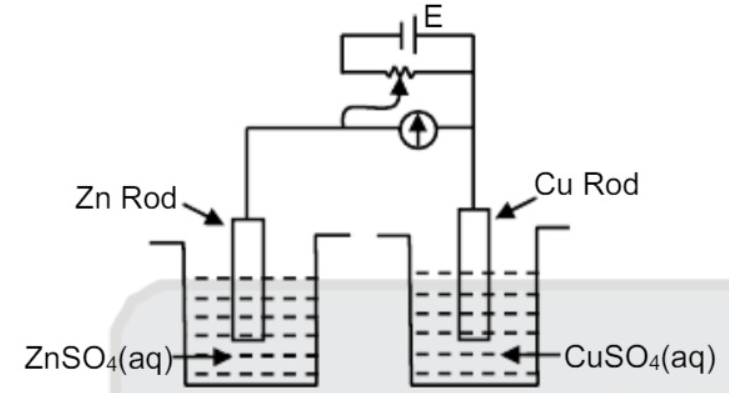Copper from copper sulphate solution can be displaced by …………. The standard reducation potentials of some electrodes are given below:
(a) E∘(Fe2+,Fe)=−0.44V
(b) E∘(Zn2+,Zn)=−0.76V
(c) E∘(Cu2+,Cu)=+0.34V
(d) E∘(H+,1/2H2)=+0.34V
H2
Zn
Cr
Fe
All have more E∘OP values than EOCu
Topper's Solved these Questions
- ELECTROCHEMISTRYBOOK - P BAHADURCHAPTER - ELECTROCHEMISTRYEXERCISE - (A) ELECTROLYSIS
2 Videos
- ELECTROCHEMISTRYBOOK - P BAHADURCHAPTER - ELECTROCHEMISTRYEXERCISE - (B) ELECTRODE POTENTIAL AND EMF
1 Videos
- DILUTE SOLUTION AND COLLIGATIVE PROPERTIESBOOK - P BAHADURCHAPTER - DILUTE SOLUTION AND COLLIGATIVE PROPERTIESEXERCISE - Exercise 9 Advanced Numerical
12 Videos
- MOCK TEST PAPERBOOK - P BAHADURCHAPTER - MOCK TEST PAPEREXERCISE - Exercise
92 Videos
Similar Questions
The 0.1M copper sulphate solution in which copper electrode is dipped at 25∘C. Calculate the electrode potential of copper electrode.
[Given : E0Cu+2/Cu=0.34V]
View SolutionThe standard reducation potential E∘ for half reactions are
Zn→Zn2++2e−,E∘=−0.76V
Fe→FE2++2e−,E∘=−0.41V
the EMF of the cell reaction
Fe2++Zn→Zn2++Fe is
View Solution
Knowledge Check
Copper from copper sulphate solution can be displacesd by. (The standard reduction potentials of some electrodes are given below):
Eo(Fe2+/Fe)=−0.44V,Eo(Zn2+/Zn)=−0.76V
Eo(Cu2+/Cu)=+0.34V:Eo(Cr3+/Cr)=−0.74V
Eo(H+0H2)=0.00VAH2BZn oxidizes. FeCCrDAll of theseE∘ of Fe2+/Fe=−0.44V,E∘ of Cu/Cu2+=−0.34V .
Then in the cellACu2+ Oxidizes FeBFe2+ oxidizes CuCCu Reduces Fe2+DFe reduces Cu2+The standard cell potential for the cell Zn∣∣Zn2+(1M)∣∣∣∣Cu2+(1M)∣∣Cu
Given E∘Cu2+/Cu=0.34V and E∘Zn2+/Zn=−0.76V isA1.10 VB−0.42VC−1.10VDNone of these
The values of the standard oxidation potentials for some reactions are given below :
Zn→Zn2++2e−,E∘=+0.762VFe→Fe2++2e−,E∘=+0.440VCu+Cu2++2e−,E∘=−0.345VAg→Ag++e−,E∘=−0.800V
Which one of the following is most easily reduction undergo ?
View SolutionFor the given cell arrangement identify incorrect statement
given E∘_(Cu2+/Cu) = 0.34V &E∘_(Zn2+/Zn)=−0.76V
View SolutionThe standard reduction potential data at 25∘C is given below
E∘(Fe3+,Fe2+)=+0.77V,
E∘(Fe2+,Fe)=−0.44V,
E∘(Cu2+,Cu)=+0.34V,
E∘(Cu+,Cu)=+0.52V,
E∘(O2(g)+4H++4e−→2H2O]=+1.23V
E∘[(O2(g)+2H2O+4e−→4OH−)]=+0.40V,
E∘(Cr3+,Cr)=−0.74V,
E∘(Cr2+,Cr)=−0.91V,
Match E∘ of the redox pair in List-I with the values given in List-II and select the correct answer using the code given below teh lists:
List−IList−II(P)E∘(Fe3+,Fe)(1)−0.18V(Q)E∘(4H2O⇔4H++4OH+)(2)−0.4V(R)E∘(Cu2++Cu→2Cu+)(3)−0.04V(S)E∘(Cr3+,Cr2+)(4)−0.83V
Codes:
View SolutionStandard reduction potential values for the electrodes are given below.
Mg2+2e−→Mg is−2.37V
Zn2++2e−→Zn is−0.76V
Fe2++2e−→Fe is−0.44V
Which of the following statement is correct
View SolutionCalculate the maximum work that can be obtained from the decimolar Daniell cell at 25∘C.
Given Ec−.(Zn2+∣Zn)=−0.76V and Ec−.(Cu2+∣Cu)=0.34V
View Solution
